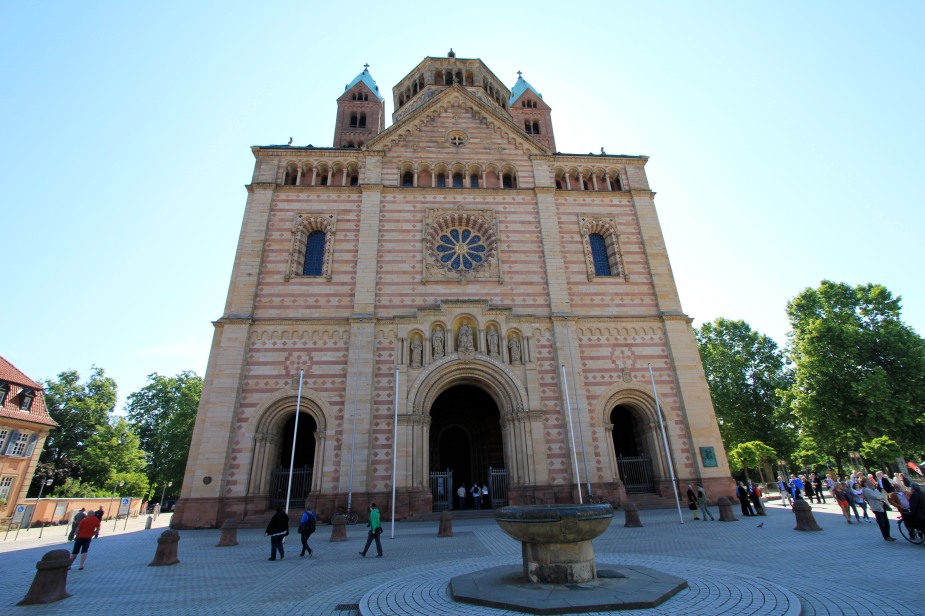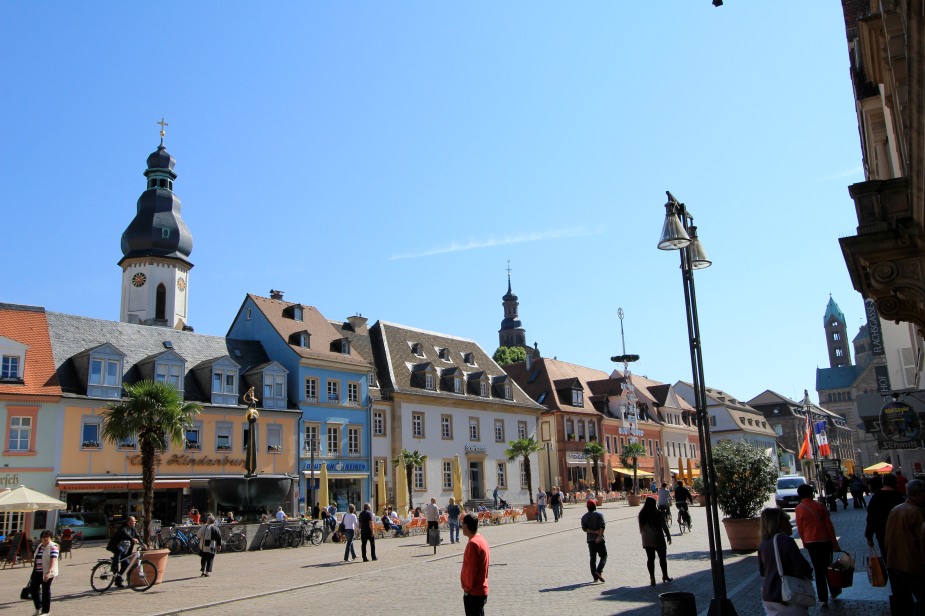Speyer is located about 20 minutes south of where we live in Ludwigshafen, and was settled about 5000 years ago by early nomadic tribes. In about 10 BC, Speyer became a settlement as part of the Roman Empire. As with this part of Germany, the Rhineland-Palatinate area has been settled numerous times between the Romans, Germans, French, Swedes, Spanish, and eventually back to the Germans. This region of Germany also saw turmoil between the Catholics & Protestants during the Thirty Years War in the mid 1600s.
The result of all this historic turmoil created this beautiful city which is an easy day trip from Mannheim, especially if visit here first before heading over to Heidelberg.

The catholic Speyer Cathedral, the most visible landmark in Speyer. Begun in 1030 under Conrad II, the imposing triple-aisled vaulted basilica of red sandstone is the largest Romanesque architecture-style church.
- Total length: 134 m (444 feet) (from the steps at the entrance to the exterior wall)
- External width of the nave (with aisles): 37.62 m (122 feet) (from exterior wall to exterior wall)
- Height of the eastern spires: 71.20 m (232 feet)
- Height of the western spires: 65.60 m (217 feet)

From a distance, it is hard to get a sense of how large the church is until you get closer….here my Mom is standing in front of the door to the church

In 1024, Conrad II commissioned the construction of the Christian Western world’s largest church in Speyer which was also supposed to be his last resting place. Construction began 1030 on the site of a former basilica which stood on an elevated plateau right by the Rhine but safe from high water.

Under the main alter are laid the rest the remains of eight emperors and kings and a number of their wives: Conrad II (died 1039) and his wife Gisela († 1043) Henry III (died 1056), son of Conrad II. Henry IV (died 1106), son of Henry III, and his wife Bertha (died 1087) Henry V (died 1125), son of Henry IV. Beatrice I (died 1184), second wife of Frederick Barbarossa and their daughter Agnes King Philipp of Swabia († 1208), son of Frederick Barbarossa King Rudolph of Habsburg (died 1291) King Adolph of Nassau (died 1298) King Albert I of Germany (died 1308), son of Rudolph of Habsburg

View from the steps of the Cathedral. The cauldron in the middle of the street…in the Middle Ages, the Bishop would fill it with wine for the villagers to drink from
Speyer was also home to one of the most important Jewish communities in Middle Ages in northern Europe. Bishop Hutzmann and Salic emperor Henry IV encouraged Jewish refugees from Mainz to the Jewish community. This community existed until the beginning of the 16th century. The exact time and circumstances of the destruction are unknown. The Jewish courtyard was the central area of the Jewish quarter in Speyer and consisted of the synagogues for men and women as well as the Jewish Bath for ritual washing.

 The main street of Speyer has beautifully decorated buildings of shops and cafes that get very busy on Saturday afternoons.
The main street of Speyer has beautifully decorated buildings of shops and cafes that get very busy on Saturday afternoons.




